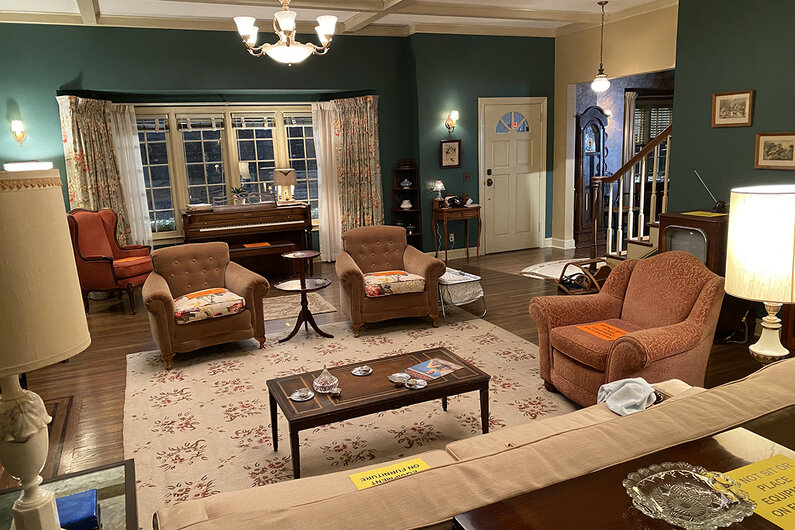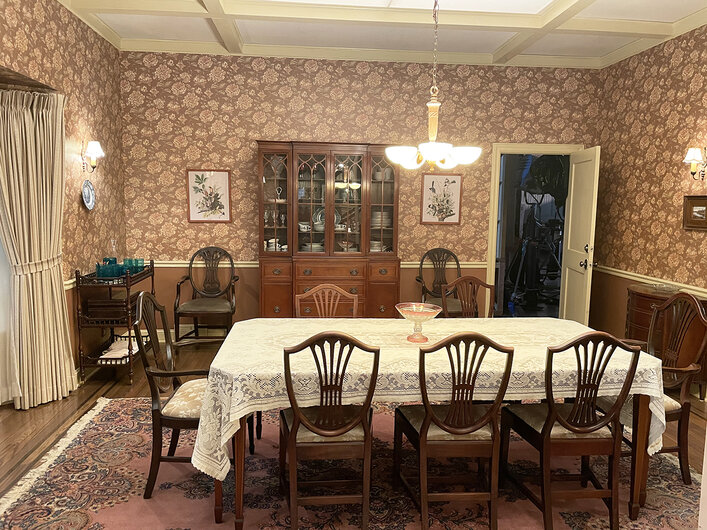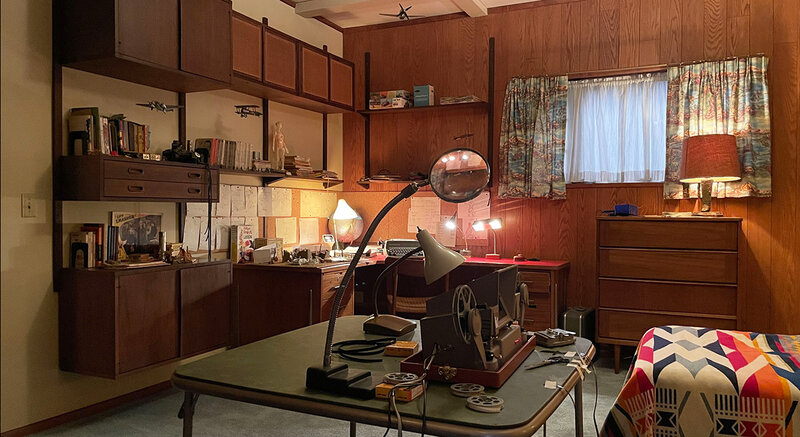Dealing with a person’s past can be tricky. You might wonder if a writer or director is going too deep into their own memories, and they cannot get out of their own way. That doesn’t seem to be the case with Steven Spielberg’s The Fabelmans, the most personal film of the director’s oeuvre. Production designer Rick Carter and set designer Karen O’Hara didn’t have that problem at all. It was an organic, emotionally open experience, and they plunged themselves into the family’s past to recreate the history of the Oscar-winning filmmaker.
Stepping into the collaboration for Carter wasn’t difficult, because this is his eleventh collaboration with the director. Carter has worked on the fantastical worlds of Jurassic Park, Minority Report, and the historical words of Amistad, and Munich (to name a few). This is the first time O’Hara worked with Spielberg, and she makes everything feel so lived-in and natural. We never question the authenticity of details we see in the Fabelmans’ homes–no matter where they traveled to next.
“Because I’ve known Steven for quite a while, there is a dialogue already there,” Carter began at the top of our interview. “I don’t know specifics, but, when he sent the script, I was easily able to grasp it. He has an extensive archive, so we were given access to photos from his New Jersey house days and the Phoenix area era. We had a good idea from the beginning of what his childhood looked like. He was very forthcoming with descriptions with what he remembered, and his sisters helped quite a bit. When Karen came on, it was amplified by all the remembrances that he had.”
“Steven was very welcoming, so I wasn’t nervous,” O’Hara added. “Since Rick and I are around the same age, it was an era that I knew. You have that as part of your soul. There was a lot of research from Steven’s archives that we could pull from.”

The Fabelmans live in three main houses: in New Jersey, Arizona, and California. Each house has it’s own distinctive look because of where in the country it is located, but we see details change throughout. When the film opens, there are a lot of cream colors, and Burt and Mitzi’s bedroom features a lot of floral accents. When they move to the Phoenix area, the kitchen has a lot of blue or turquoise accents (that double blue oven in the wall is to die for), and the pair talked a lot about research and leaning into Spielberg’s archives to make it authentic as well as functional.
“It is part of the production design that is invisible, but it is the progression of the film–that post-World War II style of living with the grandparents,” Carter said. “It is more colorful at a beginning, but when it moves into that middle zone, it turns into this manifest destiny of Sam as they move across the country. It goes from the desert to the promised land, but it’s not played out perfectly. The first two environments were based on real places where Steven grew up. The third environment was made up, because there was not one place so that’s how we came up with the craftsman house. That was part of the design–the progression. Even if it’s not a perfect place, I think there is a warmth when it comes to the environments. Karen is such the heart of the details, and The Fabelmans is so much about the set decoration.”
“The main difference for the family, back in New Jersey, was a big presence of the parents,” O’Hara revealed. “A lot of the furniture was from the ’40s and there were a lot of hand-me-downs. Then Sam’s family begins to look towards the future. The house in Phoenix was a mid-century home, and it was that kind of suburban house. We had some richer colors like dark green and rose in the New Jersey house, but in the Phoenix house, there are a lot of neutral colors like sands and taupes. We did copy a lot of things–that was their kitchen table and chairs. There’s a lot of pictures of them sitting around that table. There was a lot of turquoise and blue green to keep it more of that time. Those were the fixtures that we could find with the appliances that would work.”
“There’s not too many movies where the set dressing is the point of the scene,” Carter added. “One is with the John Ford character played by David Lynch where the posters and the paintings play such a big role in the exposition of the scene with the talk is about the horizon. That’s really a metaphor for giving Sam the key on an almost text level and to say that with all the turmoil, it does create drama.”

In any of the Fabelmans’ homes, I loved looking at all the details that O’Hara placed in the background. We can see sketches and pieces of equipment–surely, we can even see Sam’s notes for his latest project. That contrasts greatly with Monica’s bedroom. There are plenty of pictures of Jesus next to hunky movie stars on her walls, and Carter and O’Hara revealed that her collage was based on something Spielberg saw.
“I am not interested in the generic, and this is anything but,” O’Hara said. “We were so lucky, because Sam was doing films within the film, we were able to nab those storyboards. That’s, for me, what makes the different. In the kitchen, the dishes that their mother collected was something that either Steven or one of his sisters remembered. Even the food that they had on the camping trip. Every person in the family remembers different things, so they would riff off of each other. That helps with fleshing out the details.”
“A lot of times you do a teenager’s bedroom, and you put in a lot of things that may seem cluttered,” Carter said. “In this case, Steven drew all the storyboards that you see, because that’s how he would’ve drawn them at the time. That’s how he still draws. He’s the one that’s making the movie in the props that he’s going to make for the movie within the movie. It goes pretty deep in terms of the personalization of the objects in the room.”
At the end of the film, Sam is living with his father, Burt, in Los Angeles, and the dynamic is quite different from the first house we see in New Jersey. Think of the security in Sam’s childhood home and how that pertains to the traditional sense of the American dream of the 1950’s. In LA, the father and son are living in close quarters with one another, but there are touches of history throughout.
“What we decided was that his father would take what was important to him,” O’Hara said. “Mostly what we put in there was functional. It’s only a one bedroom, so Sam was in and out and he would only briefly stay. He was trying to make it at school, so we alluded that he was probably just sleeping on the sofa. It was a small space that his father was inhabiting. His work was important to him and so were his books. I have a feeling that Sam was still quite angry with his father at that time. It was furniture that was reasonably priced at the time.”

“That is where the movie is different than the reality,” Carter said. “Steven doesn’t know everything that Sammy knows, so that’s why everyone watched 25 years of the missing father with a bit of anger. That’s not the case. Now we get 25 years of the father whether it be Saving Private Ryan or Lincoln even The BFG. We did bring in some of the Jewish books that was the through-line from the beginning to the end.”
“Steven had a very specific set of books that were in his family homes,” O’Hara noted. “When his parents got divorced, his father took those books. They went everywhere.”
When we circled back to the home in New Jersey, I mentioned how a young Sam Fabelman would marvel at all of the televisions in his family’s basement. Did he keep seeing his reflection staring back at him? It’s hard to shake that notion when this is Spielberg’s most personal film to date.
“There was a scene that was cut where the TVs come alive in the living room,” Carter revealed. “I remember [how] a shot from the screen, and even the oscilloscope, with its vibrations, calmed his brain down. There are a lot of different things in there that are not important to Steven as an artifact, but it goes into the interior of what kind of brain that he has. And it comes out in subtext when it comes to struggles of a family whether it’s in something like Close Encounters [of the Third Kind] or something else. Both his uncle and John Ford tell him that it’s going to tear him apart, but Ford tells him about not getting lost in his emotions. It makes it dramatic. Celebrate that.”
The Fabelmans is in theaters now.





![2025 Oscars: Can a Late-Breaker Still Win Best Picture? [POLL]](https://www.awardsdaily.com/wp-content/uploads/2024/10/gladiator-350x250.jpg)
